Menus
- Best companion for the really big trip
- Cult bike video Africa Twin
- Tips and tricks for the XRV 650
- In detail: Honda XRV 650
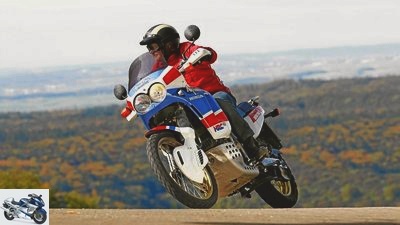
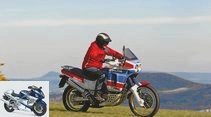
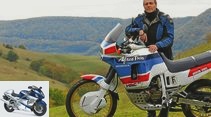
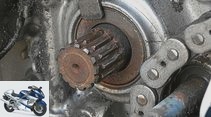
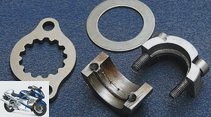
13 photos
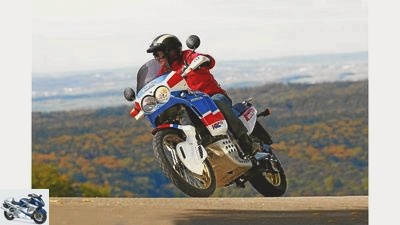
1/13
On the move with the Honda XRV 650 Africa Twin.
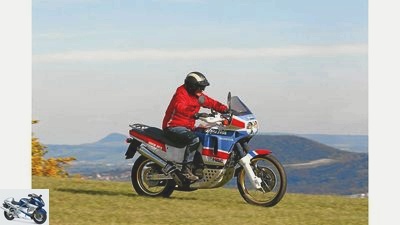
2/13
Optically a dream of a motorcycle – the Honda XRV 650 Africa Twin.

3/13
Harry Spielvogel, Classic reader, Africa Twin fan and adventurer from the very beginning, with his almost new XRV 650 of the type RD 03, which he kindly left to the editorial staff for this photo production

4/13
Due to the inclined position of the loosely fixed pinion, the multi-toothing only carries points and works the teeth at an angle.

5/13
Classic was looking for a permanent solution and found it. A split clamp, made on a simple lathe, replaces the standard safety device.

6/13
Breakage of the soldering point on the ignition box: In the long run, only exchanging it for an expensive original box or an inexpensive copy.
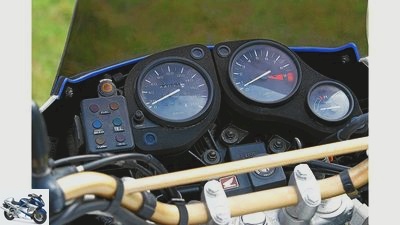
7/13
Classic, clearly drawn round instruments, embedded in a shock-absorbing foam rubber surround. The indicator lights fade over the years from exposure to sunlight and become blind.
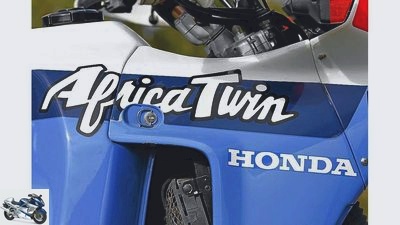
8/13
Honda Africa Twin logo.
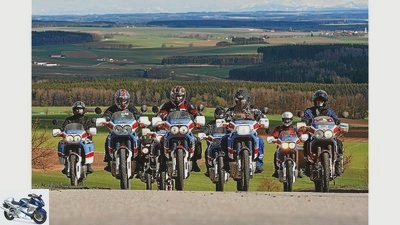
9/13
So many in one place – the Honda XRV 650 Africa Twin.
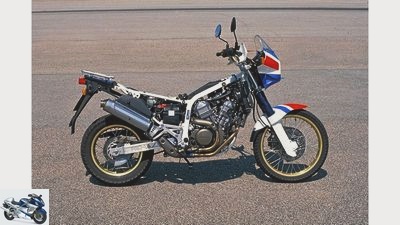
10/13
A very tidy technology is hidden under the plastic and tank, which is easily accessible despite the tightness in the double loop frame.
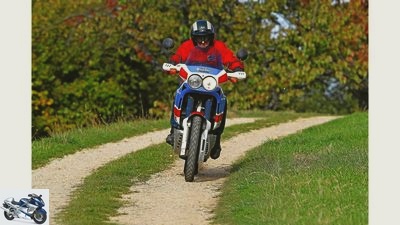
11/13
Over hill and dale with the Africa Twin.

12/13
After a mileage of more than 12,000 km, the teeth were in unchanged condition.
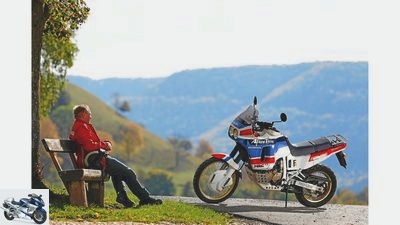
13/13
An epoch-making motorcycle: pure functionality, wrapped in a classy rally look.
On the move: Honda XRV 650 Africa Twin
Best companion for the really big trip
Content of
Robust chassis, solid engine and a range of almost 500 kilometers – the Honda Africa Twin broadened the horizon and turned good citizens into daring globetrotters.
The Honda XRV 650 Africa Twin in an individual test
There are motorbikes that you get off of, run away from and forget about faster than the lottery numbers from the Wednesday draw. Not that such bikes are bad or ugly. No, for God’s sake. But somehow soulless, insignificant. And then there are steel horses that burn into your memory like glowing branding iron into a horse’s skin. Even after years, one involuntarily flinches if one happens to come across such a motorcycle.
Buy complete article
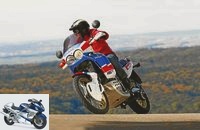
On the move: Honda XRV 650 Africa Twin
Best companion for the really big trip
Africa Twin 650, abbreviation RD03, expand my fleet with a handshake and for 1000 euros. Unlike the fiery red Honda CB 450 racer and a few half-finished youngtimer conversions, the Africa Twin shouldn’t retire with me. On the contrary: with 70,000 kilometers such a Honda V2 engine has just run in. The chassis is trimmed with a few simple steps and fresh damper oil. Everything else is made for the daily ride through the city center, as well as for the rough excursion over gravel and scree. Just great, the old XRV 650. And a motorcycle made of real shot and grain, one with a soul.
My first contact was exactly 25 years ago, when the Honda had to compete against the BMW R 80 GS (issue 13/1988) in the MOTORRAD comparison test. Japanese noble enduro versus the down-to-earth Bavarian boxer concept. Dust ate it, the BMW, whirled up by the 50 hp engine of the XRV 650. In the terrain and on the road, the boxer was almost blown away by a Japanese large enduro, whose inventors and designers had nailed their heads. While the BMW R 80 GS was an “off-road motorcycle” born out of necessity with ancestors inclined to the asphalt, the Honda was based on the concept and experience of an ambitious rally project. It was BMW of all people who called the Japanese onto the scene with popular victories at the Paris-Dakar with specially constructed R 80 G / S machines. They didn’t hesitate and put the works rally machine NXR 750 on the wheels. Just Honda. More on page 50.
Made for the desert, the XRV 650 was also good for showing off in front of the disco. Even if West German enduro riders hardly wanted to travel through the desert at hell’s speed at the end of the 80s, the XRV 650 community could be sure that their long-legged vehicle can do almost as much as the combative white / blue / red HRC paintwork promised. And that, although the drive was basically a very conservative piece of engine technology. Originally installed in the Honda VT 500 E, the V-Twin, spread open at a 52-degree angle, is characterized by rock-solid technology. The three valves are operated via rocker arms with maintenance-friendly adjusting screws for the valve clearance, both timing chains are automatically retensioned. A robust oil bath clutch and a no less stable five-speed gearbox transfer the power to the rear wire-spoke wheel. Provided that the sensitive teeth on the chain sprocket have not been completely worked up and refuse the positive power transmission.
The connecting rods run on two crankpins offset by 76 degrees in order to guarantee adequate mass balancing and thus smoother running despite the engine’s narrow cylinder angle. The bottom line is that the real crank pin offset is 128 degrees (52 plus 76 degrees), which clearly trims the V-engine in the direction of a smooth-running 180-degree in-line two-cylinder, because the pistons zoom up and down in the cast liners in almost opposite directions. With the advantage that the only minimal offset of the cylinders from the central axis (connecting rod width plus central hub disc) generates significantly lower mass moments than a two-cylinder in-line. This enabled Honda to save a balance shaft and thus weight.
So many in one place – the Honda XRV 650 Africa Twin.
So much for the theory, which is confirmed in practice. If you take the slightly edgy vibrations above 6000 rpm aside, the 650 twin actually purrs like the much-cited kitten. And that’s how it stays. The good-natured Africa Twin 650 was not born with wild hissing and erratic dynamics, because with real 50 hp, the Honda outperformed the then popular four-stroke single-cylinder enduros like a Yamaha XT 600 Tenere or Honda XL 600 R by just six hp – with a whopping 50 kilograms more weight. In addition to a skilled mechanic, the much greater technical effort involved in repairing the V2 also requires a lot of tools to properly sort the countless screws, screws, hoses and lines of the water-cooled twin. This made the rock solid V2 pretty much the opposite of the simple single cylinder.
The air-cooled Yamaha engines, for example, could practically be dismantled in the deepest jungle and in candlelight with the on-board tools – and sometimes had to. Because piston jams, whistled cylinder head gaskets and similar hardships forced the adventurer to do so. Honda, however, went the other way. And planted an engine between the wheels of the Africa Twin that was inherently hard to break. The emphasis is on hardly, because the 650 engine was not indestructible either. Still, compared to the capricious single-cylinder engines, the Honda drive was a safe bet for all globetrotters and desert foxes. Also because the XRV 650 had some vital components in its luggage in duplicate. With two spark plugs per cylinder head, each with its own ignition coil and a separate ignition box for each cylinder, the Africa Twin made it to the finish line in the worst case with just one cylinder. Proof of the legendary reliability of the Honda XRV engines was provided by the machine from Classic reader and Honda fan Harry Spielvogel, who also gave us his new RD 03 for the photo drives. With an engine from the 750 series, the Swabian spooled 275,000 kilometers with minimal maintenance and basically filled with the cheapest oil.
Optically a dream of a motorcycle – the Honda XRV 650 Africa Twin.
Keyword oil: Many XRV engines blow the lubricant through the exhaust, because piston and oil control rings do not do their jobs as the inventors thought. Anyway, the popularity of the XRV 650 25 years after its debut is terrific. And the fan base of the XRV series with great passion.
I almost forgot the chassis because of the engine technology. Maybe because it works as well and inconspicuously as the engine. In the front a fork with solid 43 mm stanchions behind the beautiful blue bellows, in the back a very fine aluminum swingarm that presses the gas spring strut with a reservoir, which was unique at the time, via a Pro-Link lever with cage-free needle bearings. The Honda technicians can be forgiven for the fact that the pressure setting screw has a placebo effect and only reacts when you either turn it up or down completely. Especially since the XRV 650 does not mutate into a rocking horse even with a full 25-liter tank and, depending on the tires, whips quickly around the bends.
No wonder that the front 296 brake disc behind the plastic cover, which was mandatory at the time, worked up a sweat when fully loaded – after all, with a maximum payload of more than 400 kilograms of total weight push forward powerfully and force you to handle the battered brake system with care. But the bottom line is that I still take my hat off to what Honda put in the sales room 25 years ago for 11350 marks.
Cult bike video Africa Twin
Which brings us back to the beginning of the story and ask the question again: How, if you go, can a motorcycle like the XRV 650 that is subject to pure function and objectivity burn itself into the hearts of passionate motorcycle freaks? Only exotic people, outsiders, capricious and beautiful Italians or genuine classics can do that. My answer: Exactly with the characteristics of the RD 03, which, despite its mercilessly objective function, reveals the handwriting of totally motorcycle-crazy designers in every detail. Designers who actually managed to tease the man with the red pen with two ignition boxes, two ignition coils, a spotlessly welded aluminum swing arm and fine quick-release fasteners for the three-color painted trim parts. After that, the brave calculator can actually only have hung himself on the double cable harness – or after the approval for the series with the motorcycle-crazy engineers, he cast one behind the band. We fervently hope for the second solution. The mere fact that the XRV 650 had almost overrun the big rival BMW R 80 GS in the first comparison test 25 years ago should of course have justified the high cost of materials and thus the hopefully quite happy drinking binge.
In any case, this comparison a quarter of a century ago fully kindled my passion for the Africa Twin. And I was not alone: weeks before that, my very esteemed editorial colleague Fred Siemer had initiated the first test of the XRV 650 with the question of whether anything could be improved after the introduction of the 1987 Honda Transalp 600. His answer: “After just a few kilometers, it was clear: almost everything.” And with this in mind, I would like to quote a KTM development boss who is not mentioned by name and who recently “caught” me while studying the old reports and documents about the XRV 650 and the Honda unabashedly courted: “The Africa Twin was a real milestone, everything really worked out.” There is probably nothing more to add.
Subscribe to MOTORRAD videos on Youtube
Tips and tricks for the XRV 650
After a mileage of more than 12,000 km, the teeth were in unchanged condition.
As robust as the innards of the Honda gearbox, the short, toothed shaft stub on which the chain pinion is mounted with a floating bearing is fragile. Due to the inclined position of the loosely fixed pinion, the multi-toothing only carries points and works the teeth at an angle. Classic was looking for a permanent solution and found it. A split clamping fist, made on a simple lathe, replaces the standard safety device and supports the pinion against twisting on the shaft. After a mileage of more than 12,000 km, the teeth were in unchanged condition.
Another source of error: In the XRV, the seat presses so unfavorably on the ignition box that the soldering point on its plug connection in the housing can break. If necessary, you can make do with a cable tie lashed around the plug contact. In the long run, the only thing that helps is to replace it with an expensive original box or an inexpensive copy that has the original connections and can therefore be easily installed.
In detail: Honda XRV 650
A very tidy technology is hidden under the plastic and tank, which is easily accessible despite the tightness in the double loop frame.
(1988-1989)
Price 1988: 10,750 marks
Data (Type RD 03)
Engine:
Water-cooled two-cylinder four-stroke V2 engine, ohc, three valves per cylinder, actuated via rocker arm, displacement 647 cm³, power 37 kW (50 PS) at 7000 / min. Power transmission: multi-disc oil bath clutch, five-speed gearbox, chain drive
Landing gear:
Double loop frame made of tubular steel, telescopic fork, Ø 43 mm, aluminum swing arm, central spring strut, wire-spoke wheels with aluminum rims, tires 90 / 90-21 front, 130 / 90-17 rear, disc brake front, Ø 296 mm, disc brake rear, Ø 240 mm
Mass and weight:
Wheelbase 1555 mm, weight with a full tank 220 kg
Mileage:
Top speed 168 km / h
technology
The engine base of the Africa Twin series originally comes from the Honda VT 500 E (1983). The compact V2 with its three-valve cylinder heads is not designed for maximum performance, but for torque and slow speeds in terms of its design of the power components and duct cross-sections. The suspension travel of the solid tubular steel chassis, at 220 and 210 millimeters, is on par with off-road enduro bikes, and the tire dimensions and wheel sizes are also uncompromisingly geared towards off-road capabilities.
Checkpoints
After the huge 25-liter tank has been dismantled, the engine is sufficiently accessible to carry out the necessary maintenance work, in practice only valve clearance checks. If the consumption is too high, between 4.5 and 6.5 liters, depending on the driving style, the choke cables should be checked to ensure that they move freely. Weak points are also the fuel pump, which can be bypassed if the tank is sufficiently full, the ignition boxes already mentioned and the problem of the toothing on the gearbox output shaft. You can live with increased oil consumption, especially since the symptom usually does not indicate serious engine damage. Original fetishists are visually disturbed by the switch units, which are often bleached by the sun, and the barely visible control lights in the cockpit. Very susceptible to corrosion, often not much remains of the standard painted steel silencer after a good 25 years. The mileage hardly plays a role and many RD 03 therefore have a retrofit damper. The stainless steel elbows, on the other hand, are made to last. The torn off remains of the fastening screws are often only found in the M6 threads of the heat plates.
market
Depending on the condition, you have to calculate between 1200 and almost 4000 euros for one of the now rare XRV 650. Many Africa Twin of the first series are still in first ownership or were bought by RD 03 drivers from the very beginning. They care for and cherish the good piece with a lot of devotion, whereby one or the other component has been refurbished with better accessories (bench, windshield) or more travel-friendly equipment.
Specialists
African Queens, Holledaustrabe 10, 85301 Geisenhausen-Schweitenkirchen,
Telephone 084 41/18442 (accessories, conversion parts, chassis, tuning)
Powered by Mende
An der Jagerhutte 14, 31020 Salzhemmendorf, phone 051 53/963001 (engine tuning, displacement expansion)
Internet
Information, scene, meeting around the Africa Twin models: Friends of the Africa Twin,
www.africatwin.de
Related articles
-
Honda CRF 1100 L Africa Twin (2020) in the driving report
Motorcycle fair in Milan EICMA 2019 Presented by Honda 14th photos Honda 1/14 The base model Honda CRF 1100 L Africa Twin comes exclusively with the…
-
www.factstudio.de 16 photos www.factstudio.de 1/16 Picture gallery: Impressions of the new Honda Africa Twin and Werner Mini Koch’s very own twin story….
-
Honda Africa Twin (model year 2017) in the test
www.bilski-fotografie.de 15th photos bilski-fotografie.de 1/15 Honda Africa Twin. bilski-fotografie.de 2/15 Last year it was voluntary, now it is…
-
Archive pictures Honda XRV 650 Africa Twin and the driving report from MOTORRAD 09-1988
duke 17th photos duke 1/17 The more bumpy the track becomes, the more clearly the Honda can set itself apart from competitors like the BMW R 80 GS. duke…
-
Honda Africa Twin in the top test
markus-jahn.com 21st photos markus-jahn.com 1/21 The first impressions of the Honda Africa Twin when it was presented were promising. But now it applies….
-
Driving report Honda CRF 1000 L Africa Twin (part 1)
Honda 13 photos ULA SERRA PRATS 1/13 Honda Africa Twin. 2/13 270 degree crank pin offset, long, continuous shaft with two balance weights in front of the…
-
fact 12th photos fact 1/12 Top brakes: radially screwed six-piston stoppers, ABS and integral actuation. fact 2/12 Builds compact and very narrow: the…
-
BMW F 800 GT, Kawasaki Z 1000 SX and Honda VFR 800 F in the test
fact 44 photos fact 1/44 fact 2/44 fact 3/44 fact 4/44 fact 5/44 In praise of diversity: the three test candidates all want the same thing, but try to…
-
markus-jahn.com 21st photos markus-jahn.com 1/21 The first impressions of the Honda Africa Twin when it was presented were promising. But now it applies….
-
BMW R 1200 GS Rallye and Honda Africa Twin in comparison test
factstudio.de 19th photos fact 1/19 With the “Rallye” GS, BMW underscores the “enduro” behind the “journey”. Honda did this from the start with the…